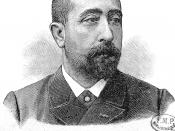brief overview of syndrome -
Tourette Syndrome
Tourette Syndrome was named for Georges Gilles de la Tourette, who first described the syndrome in 1885. Although the disease was identified in 1885, today in 1996, there still is a mystery surrounding Tourette Syndrome, its causes and possible cures. Tourette Syndrome is a neurological disorder that researchers believe is caused by and abnormal metabolism of the neurotransmitters dopamire and serotonin. It is genetically transmitted from parent to child. There is a fifty percent chance of passing the gene on from parent to child (Gaffy,Ottinger). Those most at risk are sons of mothers with Tourette Syndrome. About three-quarters of Tourette Syndrome patients are male. Males with the disorder have a ninety-nine percent chance of displaying symptoms. Females, have a seventy percent chance of displaying symptoms. This ration of 3-4:1 for males and females may be accounted for by referral bias. Also, there is a frequent number of reported cases within the Mennonite religious isolate population in Canada.
The specific genetic transmission however, has not been established. Some researchers believe that the mar is on an autosomal dominant trait. Some cases however are sporadic, and there may not be a link to family history involved. These cases are mild however, and not full blown. The onset of Tourette Syndrome must be before the age of fifteen, and usually occurs after the age of two. The mean age onset of motor tics is seven. The mean age onset for vocal tics is nine. In order for a person to be classified as having Tourette Syndrome they must have both multiple motor tics and vocal tics. These tics however do not have to occur everyday. In fact, affected individuals may rarely exhibit all of the symptoms, or all of the tics. The vocal and motor...


